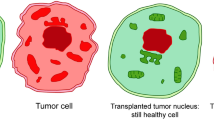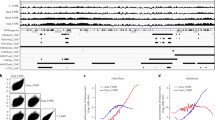Abstract
In 1979, the mechanism of chemical carcinogenesis, a challenging and difficult scientific problem pending for a number of years, was explained by Dai Qianhuan. The mechanism named di-region theory predicted that a carcinogen always metabolizes to form a special bi-functional alkylating agent. This agent induces cross-linkages between the complementary base pairs in DNA and switches on initial mutageneses in genomes including point and frameshift mutations. This, in turn, induces further deep mutageneses including the production of various chimeric chromosomes, deletions and other aberrations found in genomes. In the end this initiates carcinogenesis of the whole cell through the reverse transcription mechanism after a lengthy incubation period. Recently, this laboratory has verified that physical carcinogenesis, including the oncogenesis induced by radiation and asbestos as well as the carcinogenesis induced by endogenous factors such as estrogen or diethyl-stilbestrol switch on carcinogenesis by inducing the formation of cross-linkages between the complementary base pairs in DNA.
Di-region theory has now been supported by many experimental observations such as mutational spectra of various carcinogens. The potential for carcinogenesis, teratogenesis, sterility and mutagenesis lumped together as genetic toxicity appears to originate almost uniformly from the cross-linking between complementary bases, i.e. malignant cross-linking, which is in accordance with di-region theory. Other forms of cross-linking between non-complementary bases, benign cross-linkings, show bi-functional alkylation anticancer activity but lack genetic toxicity. The predictable design and synthesis of a high selectivity anticancer agent with high efficacy and low genetic toxicity, a goal long pursued in cancer chemotherapy, have been realized for the first time in this laboratory by inhibiting malignant and heightening benign cross-linking using the principles of di-region theory. A series of patented new anticancer platinum complexes called di-regioplatins, based on the above predetermined design, have been reported. In these cancer cell kill rates, tumor-inhibition rates and the ultimate life-span for two mouse carcinoma models using several com-pounds of cis-di-substituted-benzylaminodihaloplatinum (II) are notably higher than those of cisplatin, but their toxicities all are much lower than cisplatin. Based on a predictive design using di-region theory and group theory, a new anticancer complex, cis-diammine-cyclopentane-1,1-dicarboxylato-platinum (II) called minoplatin, has been synthesized in this laboratory by making the minimal structural revision of adding an CH2 unit on the four-member ring of carboplatin.
The water solubility of minoplatin is almost double that of carboplatin, yet its lipid solubility is much higher than carboplatin. Animal acute toxicity of minoplatin is only half that of carboplatin, and the curative effect of minoplatin in a rapid growing animal tumor model of the ascites-type is remarkably higher than that of carboplatin. Genetic toxicity of minoplatin as measured by reverse mutagenesis with the TA 102 strain is only 1/200 of cisplatin and 1/10 of carboplatin. Minoplatin, as opposed to cisplatin, shows no teratogenesis to the offspring of pregnant female mice. Additionally, some recent empirical research results on anticancer platinum complexes have been explained by the di-region theory, and comments from the perspective of predicting the selectivity of anticancer agents have been presented. We anticipate that future clinical testing will demonstrate that minoplatin and di-regioplatins are the first examples in a class consisting of highly selective, low toxicity, and tailored second generation anticancer agents.
Similar content being viewed by others
References
Dai, Q. H., Research on mechanism of chemical carcinogenesis and quantitative structure-carcinogenic activity relationship, di-region theory—A quantitative molecular orbital model of carcinogenic activity for polycyclic aromatic hydrocarbons, Scientia Sinica, 1980, 23(4): 453.
Dai, Q. H., Di-region theory: New discovery on mechanism of carcinogenesis, Mol. Eng. 1998, 1: 69–81.
Dai, Q. H., Di-region Theory: Mechanism of Carcinogenesis and Non-empirical Quantitative Structure-biological Activity Relationship of Carcinogens (in Chinese), Beijing: Science Press, 2000.
Dai, Q. H., Mechanism of carcinogenesis revealed through the theoretical treatment on structure-carcinogenic activity relationship of polycyclic aromatic hydrocarbons, in Polynuclear Aromatic Hydrocarbons: Synthesis, Properties, Analytical Measurement, Occurrence and Biological Effects (eds. Garrigues, P. and Lamotte, M.), Switzerland: Gordon and Breach Science Publishers, 1991, 247–258.
Dai, Q. H., Di-region theory—New conception for quantitative structure-carcinogenic activity relationship and mechanism of chemical carcinogenesis, in Polynuclear Aromatic Hydrocarbons: Mechanisms, Methods and Metabolism (eds. Cooke, M. and Dennis, A.), Ohio: Battelle Press, Columbus, 1984, 1045–1073.
Dai, Q. H., Chen, S., Li, Y. X., Carcinogenesis of asbestos switched on by inducing cross-linkage between DNA complementary pair bases, Chinese Science Bulletin, 2002, 47(13): 1086–1091.
Dai, Q. H., Liu, X., DNA interstrand cross-link induced by estrogens as well as their complete and synergic carcinogenesis, Chinese Science Bulletin, 2000, 45(23): 2125–2129.
Dai, Q. H., Lu, P., Peng, S. H., Zhang, Q. R., Carcinogenesis switched on by DNA cross-link between complementary bases aroused by aflatoxin and N-nitroso compounds, Progress in Natural Science, 2003, 13(8): 561–567.
Rawley, J. D., A new consistent chromosomal abnormality in chronic myelogenous leukemia identified by quinacrine fluorescence and Giemsa staining, Nature, 1973, 243: 290–293.
Sandberg, A. A., Chen, Z., Cytogenetics of cancer: cancer cytogenetics: Nomenclature and clinical applications, in Molecular Biology in Cancer Medicine (eds. Kurzrock, R. and Talpaz, M.), London: Martin Dunitz, 1995, 55–84.
Skalka, A. M., Goff, S. P. (eds.), Reverse Transcriptase, New York: Gold Spring Harbor Laboratory Press, 1993.
Dai, Q. H., Di-region theory for carcinogenesis and wholesale molecular orbital calculation—An example of revealing an un-known biochemical process through quantum chemical calculation, J. Mol. Structure (TheoChem), 1987, 149(1/2): 167–168.
Dai, Q. H., Di-region theory, mechanism of carcinogenesis uncovered by theoretical treatment of a quantitative structure-biological activity relationship, in Recent Advances of Chemistry and Molecular Biology in Cancer Research, (eds. Dai, Q. H., Armour, M. A. and Zheng, Q. Y.), Beijing/Heidelberg: Science Press/Springer-Verlag, 1993, 29–47.
Dai, Q. H., Xu, P. R., Xiao, P., Shi, B. Z., Synthesis of anticancer platinum complexes based upon di-region theory, J. of Beijing Polytechnic University (Beijing Gongye Daxue Xuebao), 1985, 11 (2): 145–147.
Zwelling, L. A., Kohn, K. W., Platinum complexes, in Pharmacologic Principles of Cancer Treatment (ed. Chabner, B.), Philadelphia: Saunders Company, 1982, 309–339.
Dai, Q. H.(inventor), Cis-platinum-diammine complexes and an-titumorous compositions, US patent 5,198,564; British patent 2,209,161; Chinese patent ZL 87 104027.1.
Dai, Q. H., Some research on new synthesis of chloramphenicol, Scientia (in Chinese only, cf. CA 8862114r), 1977, (9): 381-389.
Natile, G., Mauro, C., Antitumor active trans-platinum compounds, in Metal Ions in Biological Systems, Vol. 42, Metal Complexes in Tumor Diagnosis and As Anticancer Agents (eds. Sigel, A. and Sigel, H.), New York: Marcel Dekker, Inc., 2004, 209–250.
Farrell, N., Polynuclear platinum drugs, in Metal Ions in Biological Systems, Vol. 42, Metal Complexes in Tumor Diagnosis and As Anticancer Agents (eds. Sigel, A. and Sigel, H.), New York: Marcel Dekker, Inc., 2004, 251–296.
O’Dwyer, P. J., Stevenson, J. P., Johnson, S. W., Clinic experience: DACH-based platinum drugs, in Platinum-based Drugs in Cancer Therapy (eds. Kelland, L. R., Farrell, N. P.), Totowa: Humana Press, 2000, 231–249.
Allegra, C. J., Oxaliplatin in the treatment of patients with advanced colorectal cancer, in Progress in Oncology 2001 (eds. De-Vita, Jr., V. C., Hellman, S., Rosenberg, S. A.), Sudbury: Jones and Bartlett Publishers, 2001, 159.
Lenz, G., Hacker, U. T., Kern, W. et al., Adverse reaction to oxaliplatin: A retrospective study of 25 patients treated on one institution, Anti-Cancer Drugs, 2003, 14(9): 731–733.
Sarrio, R. G., Munoz, E. C., Urtasun, J. A. et al., The addition of oxaliplatin to the Mayo clinic schedule significantly increase its toxicity: A retrospective analysis of patient with advanced colorectal cancer, Revista de Oncologia (in English, cf. CA 139 111249w), 2003, 5(2): 88–92.
Cleare, M. J., Hydes, P. C., Malerbi, R. W. et al., Anti-tumor platinum complexes: Relationships between chemical properties and activity, Biochimie, 1978, 60: 835–850.
Highley, M. S., Calvert, A. H., Clinical experience with cisplatin and carboplatinm, in Platinum-based Drugs in Cancer Therapy (eds. Kelland, L. R., Farrell, N. P.), Totowa: Humana Press, 2000, 171–194.
Kelland, L. R., New platinum drugs, in Platinum-based Drugs in Cancer Therapy (eds. Kelland, L. R., Farrell, N. P.), Totowa: Humana Press, 2000, 300.
Kato, H., Fukuchi, M., Manda, R. et al., Efficacy and toxicity of nedaplatin and 5-FU with radiation treatment for advanced esophageal carcinomas, Anticancer Research, 2003, 23(4): 3493–3498.
Cremer, D., Ab initio calculation of the equilibrium structure of cyclobutane, J. Am. Chem. Soc., 1977, 99: 1307.
Neidle, S., Ismail, I. M, Sadler, P. J., The structure of the antitumor complex cis-(diammino)-(1,1-cyclobutanedicarboxylato) Pt(II): X ray and nmr studies, J. Inorganic Biochemistry, 1980, 13: 205–212.
Bauman, L. E., Laane, J., Pseudorotation of cyclopentane and its deuterated derivatives, J. Phys. Chem., 1988, 92: 1040.
Dai, Q. H., Zheng, Q. Y., Zhou, Q. L.(inventors), Cis-diammine-1, 1-cyclopentanodi-carboxylatoplatinum(II) with anticancer activity, Chinese patent ZL 94 1 17561.8, 1998-08-29.
Feng, J. C., Tang, W. X., Ji, X. J. et al., Synthesis, characterization and antitumorigenic activity of carboplatin analogous, Chinese Journal of Applied Chemistry (in Chinese), 1989, 6(3): 10–14.
Author information
Authors and Affiliations
Rights and permissions
About this article
Cite this article
Dai, Q. Explanation of the mechanism of carcinogenesis and syntheses of anticancer agents with high selectivity. SCI CHINA SER B 49, 44–62 (2006). https://doi.org/10.1007/s11426-004-0048-4
Received:
Accepted:
Issue Date:
DOI: https://doi.org/10.1007/s11426-004-0048-4




